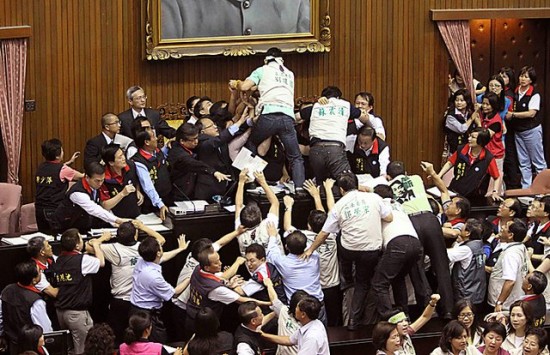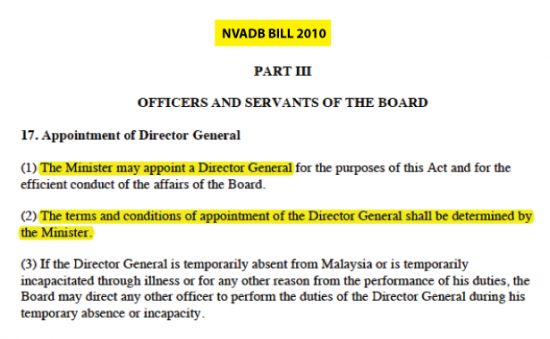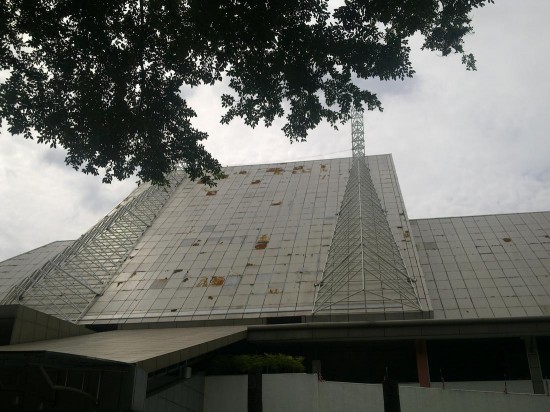


Not this bad… yet. Brawl in Taiwan’s parliament in June this year
At the 11th hour on the last day of parliament sitting for 2010, the National Visual Arts Development Board (NVADB) Bill 2010 was passed in the Dewan Rakyat. The next day parliament was extended and four Pakatan Rakyat MPs were given 6-month suspensions. With the theatrics that go on (words like ‘monkey’, ‘ape’ and ‘underwear’ are not uncommon) in parliament, it’s a minor miracle anything practical gets done at all.
Here’s a breakdown of the 2010 Bill compared to the existing National Art Gallery (NAG) Act 1959. Consider this Arteri’s present to you as we sail into a better, brighter 2011. We’re taking a well-deserved break from the internets and will back on Monday, 3 Jan 2011.
~
THE SCOPE
NAG Act 1959 clearly focuses on the founding and running of an art institution. In contrast, NVADB Bill 2010 looks at developing the visual arts as a field or industry. As a result, it is much longer, and wider in scope.
NAG Act 1959 applies only to Peninsula Malaysia, whereas NVADB Bill 2010 covers all of Malaysia.
The ‘Visual Arts’ and ‘Visual Arts Operators’ are given formal definition. In my opinion, this is significant because it recognizes the visual arts as a field with various stakeholders – an ecosystem in which different agents have their roles to play. Conceptually, we can see the visual arts as no longer ‘enshrined’ within a single institution. I would argue that this changes our relationship to and our expectations of, the NAG. There is now less reason to measure the growth of Malaysian art by the performance of NAG alone.
~
HOW DOES IT WORK? THE GALLERY, THE BOARD, THE FUND
Like many people, I’ve always been a little vague about the status and structure of NAG – is it under the Ministry of Culture, or…? If anything else, this new bill requires us to find out more about how things work, and this knowledge translates to a sense of empowerment.
In 1959, the National Art Gallery was established as a statutory body. A statutory body is an organization or institution set up by the federal government, but not under any particular ministry. Other statutory bodies in Malaysia include the Securities Commission, EPF, ASWARA, FINAS, Dewan Bahasa & Pustaka and many more. These bodies receive a yearly allocation from their concerned ministries. In the case of NAG, this annual sum of money goes into a Fund. NAG may supplement the government allocation independently (by buying and selling artworks, through corporate sponsorships, grants, enterprises, investments etc) – this also goes into the Fund. All the expenses of running NAG, including exhibitions, staff, training programmes, renovations, maintenance, etc are paid out of the Fund.
By raising its own funds, this is how NAG maintains a certain independence from the ministry.
The Board of Trustees enters into contracts, makes decisions, rules and regulations about the administration of the NAG and the Fund. They are like the directors of a company.
Once the NVADB Bill 2010 passes into law, the existing Board of Trustees will be dissolved and replaced with a National Visual Arts Development Board – this Board becomes the statutory body.
~
THE NATIONAL VISUAL ARTS DEVELOPMENT BOARD
Compared to NAG Act 1959, the functions of the Board under NVADB Bill 2010 are much wider in scope. The former is tasked to ‘do all such other things as appear to it necessary or expedient for furthering the interests and increasing the utility of the Art Gallery’ whereas the new Board is meant ‘to act in any capacity or role towards the advancement of visual arts development in Malaysia’.
~
BOARD MEMBERSHIP
In NAG Act 1959, the number of Board members was 12 – 22. There was provision for up to 11 civil servants.
NVADB Bill 2010 streamlines it down to 8 – 13 members and only specifies 3 civil servants. At least half of the remaining 5 – 10 members must consist of practicing artists or academics.
All members are appointed by the Minister. This is where the independence of the Board is potentially compromised. There are no provisions in either the 1959 Act or 2010 Bill to ensure that the Board fairly represents the interests of the art community. In hindsight, I believe this is one of the significant failings of the 2010 Bill and should have been debated in parliament.
We need detailed information about the nominations and appointment process. This is one crucial area in which we must demand for more transparency – only then would we be empowered to lobby for suitable members to sit on the Board.
~
DIRECTOR GENERAL

NVADB Bill 2010 formalizes the position of Director General, whereas there is no mention of it in NAG Act 1959.
The DG acts as secretary to the Board and is responsible for executing decisions and policies made by the Board. She or he is appointed by the Minister, with terms and conditions of appointment at the discretion of the Minister.
The fact that the DG as well the Board Members are appointed by the Minister suggests to me a lack of check and balance.
~
COMPANIES: KACHING $$
NVADB Bill 2010 empowers The Board to establish companies under the Companies Act 1965 – this means that there could be various enterprises and businesses. As an example, this would allow the NAG Art Shop to run as a business, and therefore be more profitable than it currently is.
I don’t know enough about company law to comment on possible conflicts of interest that might arise from this clause. For example, who becomes the director of these companies? Is it a single person or The Board itself?
There is a section that mentions disclosure of interest:
A member of the Board having, directly or indirectly, by himself or his partner, any interest in any company or undertaking with which the Board proposes to make any contract or having any interest in any such contract or in any matter under discussion by the Board shall disclose to the Board the fact of his interest and the nature thereof, and such disclosure shall be recorded in the minutes of the Board and, unless specifically authorized thereto by the Chairman, such member shall take no part in any deliberation or decision of the Board relating to the contract or matter.
~
NATIONAL VISUAL ARTS GALLERY/BALAI SENI VISUAL NEGARA – WHAT’S IN A NAME?
One of the curious (you could say stupid, or redundant) features of NVADB Bill 2010 is that it establishes an entirely new institution known as National Visual Arts Gallery, which presumably replaces the existing National Art Gallery.
The only conceivably good justification for this is if we were getting a new building. It’s no secret that the existing building is terribly designed and poorly constructed. After a thorough renovation costing millions not more than two years ago, the roof still looks shameful.
 What the roof looked like in September this year. Source via Daniel Chong
What the roof looked like in September this year. Source via Daniel Chong
We are NOT, however, getting a new building. As has been commented and debated on Facebook, the name change means nothing except that switching logo, signage and printed materials etc etc would cost thousands of ringgit. Furthermore, artists have expressed indignation at the disrespect that this demonstrates towards the spirit in which NAG was founded in the first place. Someone wondered if the original logo designed by Syed Ahmad Jamal would be buried along with the ‘old’ institution.
Thanks to an update from artist and curator Nur Hanim Khairuddin, we now know that some artists have successfully lobbied to retain the name ‘National Art Gallery’ and ‘Balai Seni Lukis Negara’ instead of ‘National Visual Arts Gallery’ and ‘Balai Seni Visual Negara’ respectively. A shout-out of gratitude and respect to our colleagues who did so, including cartoonist Zunar, poet Pyanhabib Rahman, Amin Iskandar, Hasmi Hashim, Rahmat Haron and Dinsman.
~
FRANCHISES
Under NVADB Bill 2010, NAG will be able to establish franchises or branches of itself all over Malaysia. This would mean higher visibility for the NAG ‘brand’ which might result in more awareness about visual art amongst the rakyat.
These branches will also mean employment opportunities for art practitioners and graduates. A significant staff overhaul is unrealistic at the current NAG, but these new branches could potentially be helmed by smaller, more vibrant and dynamic teams.
~
IN SUMMARY
As the only piece of legislation specially related to the visual arts, NAG Act 1959 was ripe for an update.
Conceptually, NVADB Bill 2010 takes a more holistic and wide ranging approach towards developing the art scene. Unfortunately the changes are cosmetic – they are mere amendments. While the functions of the Board have expanded significantly, the instruments to carry out these new duties have not been strengthened. As long as there is no democratic process to ensure that the Board is represented by a healthy cross section of the art community, it will continue to be a bureaucratic deadweight.
To repeal existing legislation is a big deal. It is a drastic step and should have been drafted in consultation with art practitioners. As a last resort, we should still have made our voices heard by petitioning Members of Parliament to debate the bill on our behalf, before it was passed. I cannot help but feel that a great opportunity to make changes that really matter has passed us by.
~
MOVING ON…WHAT CAN WE DO FOR THE FUTURE?
Marina Abramovic‘s performance Point of Contact (1980)
Firstly, the art community needs to mobilize. To do this, we must ensure that news spreads quickly across our networks. We need to identify issues that matter to us all and come together to fight on a common platform.
We should scrutinize annual reports released by the Board (released after the end of every financial year – i.e. 31 Dec) and give our feedback or complaints by writing letters and petitions.
At the beginning of September each year, the Board submits an estimate of next year’s expenditure to the Ministry. An open dialogue with art practitioners before compiling the estimate would make it possible to target specific needs, which could then be submitted in an official capacity to the Board.
That’s my suggestion: read the news, spread the news, organize an annual meeting, collectively write and sign a letter of recommendations. We do this year after year until we get what we want.
~
Sharon Chin is co-founder and managing editor of Arteri.
Sorry, the comment form is closed at this time.
[…] Continue reading Tags: 11th, arts, development, dewan, hour-on-last, last-day, national, national-visual, nvadb, pakatan, pakatan-rakyat, parliament-sitting, the-11thBookmark the permalink. ← SNOWPOCALYPSE: Blizzard Heads For New York – Business Insider Activision Blizzard Firms 2%, Sues Electronic Arts ' – American … → © 2010 The Knowledge Blog – Dominima var _gaq = _gaq || []; _gaq.push(['_setAccount', 'UA-20235547-1']); _gaq.push(['_setDomainName', '.dominima.net']); _gaq.push(['_trackPageview']); (function() { var ga = document.createElement('script'); ga.type = 'text/javascript'; ga.async = true; ga.src = ('https:' == document.location.protocol ? 'https://ssl' : 'http://www') + '.google-analytics.com/ga.js'; var s = document.getElementsByTagName('script')[0]; s.parentNode.insertBefore(ga, s); })(); […]
me, me, me!
Where can I get digital copies of the old and the new bill – for my research?
Hi Yusuf, you can download from a previous post we did on Arteri here: /2010/12/10/update-national-visual-arts-development-board-bill-2010/